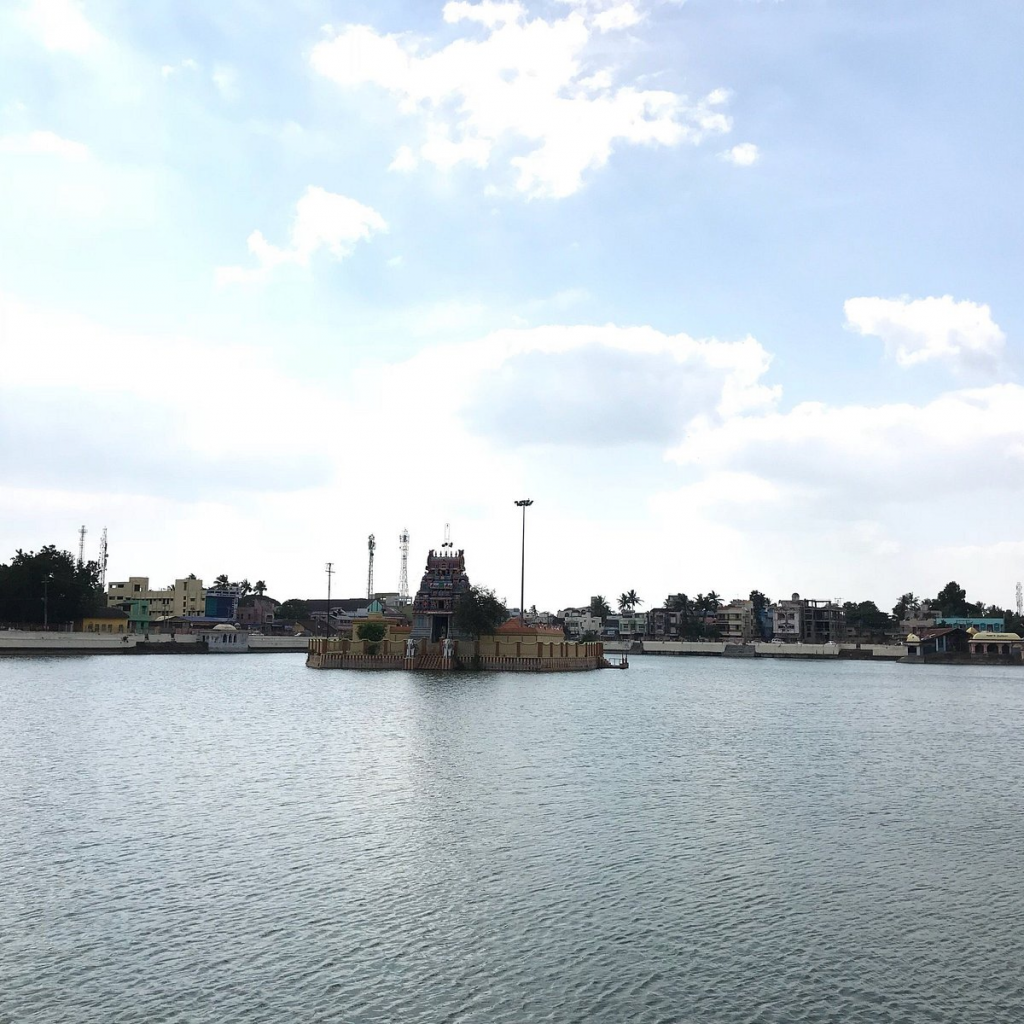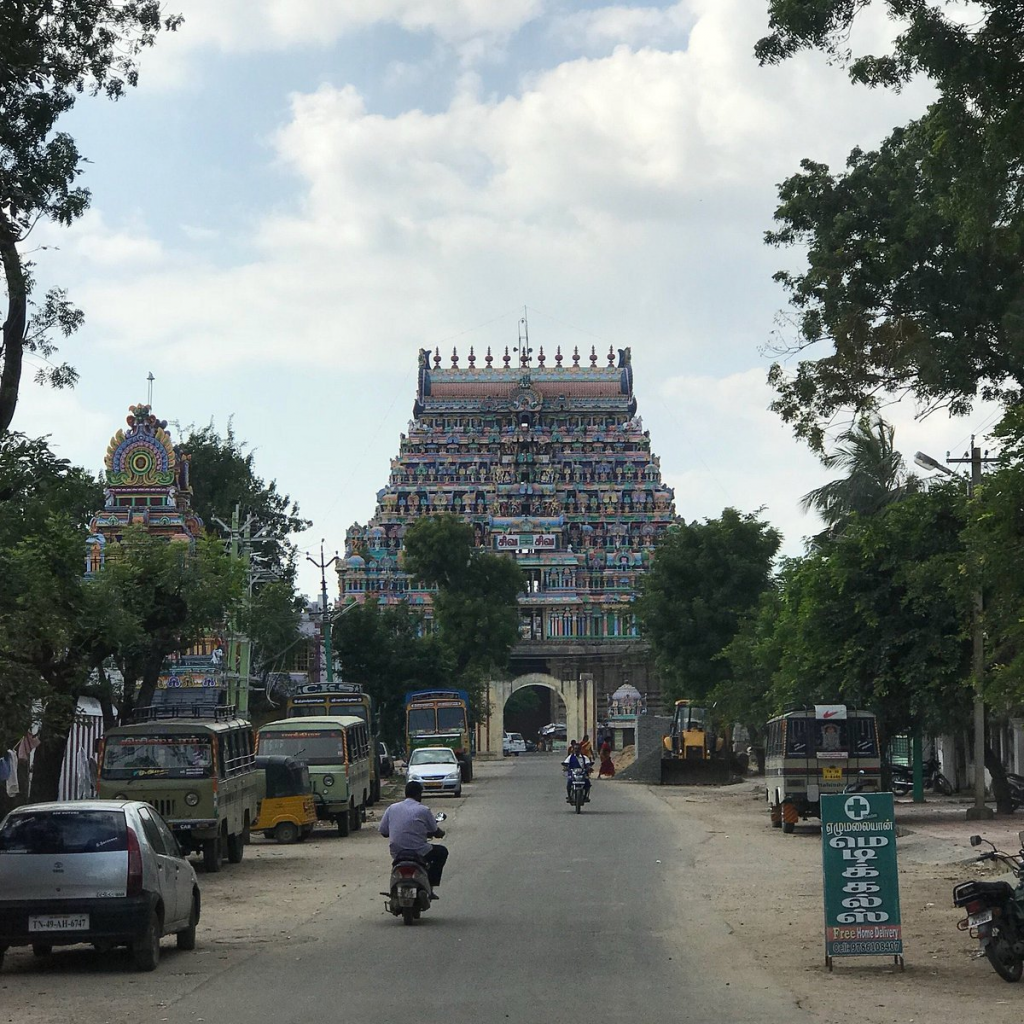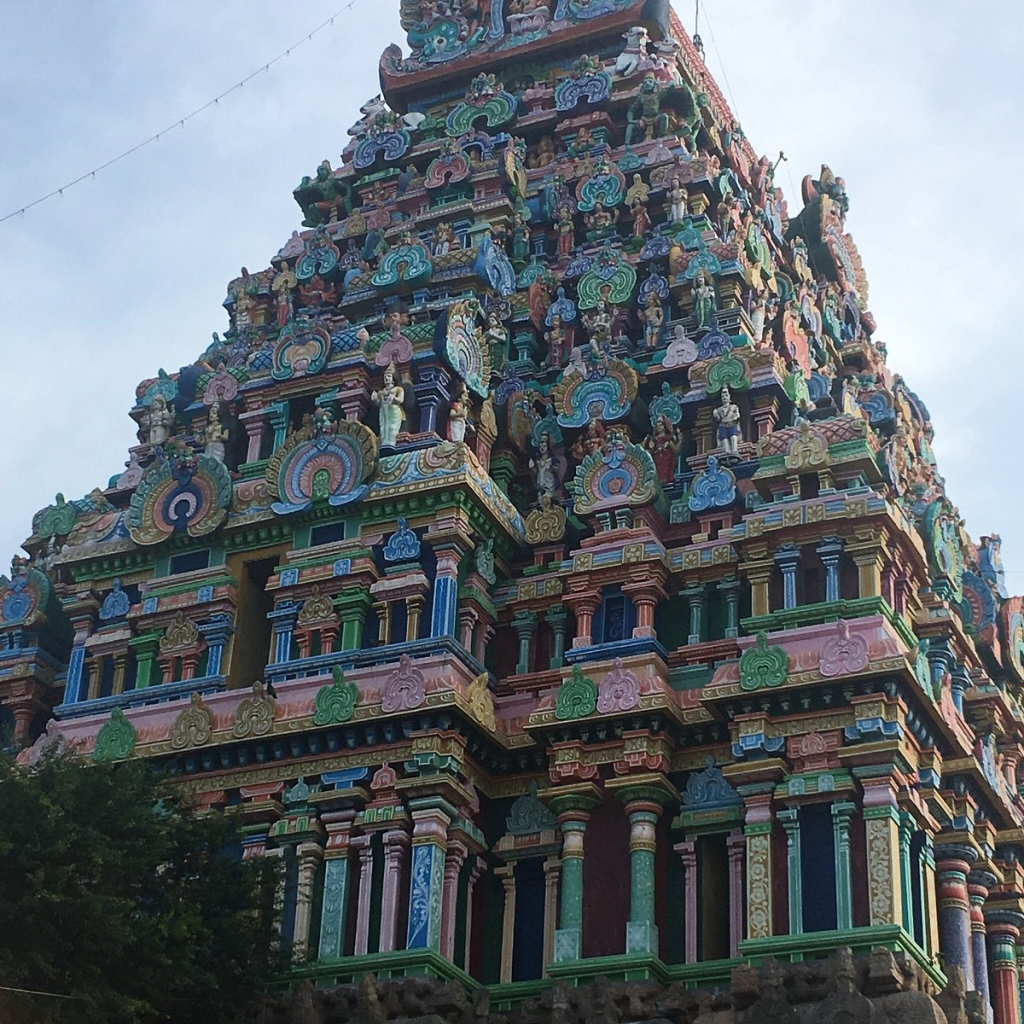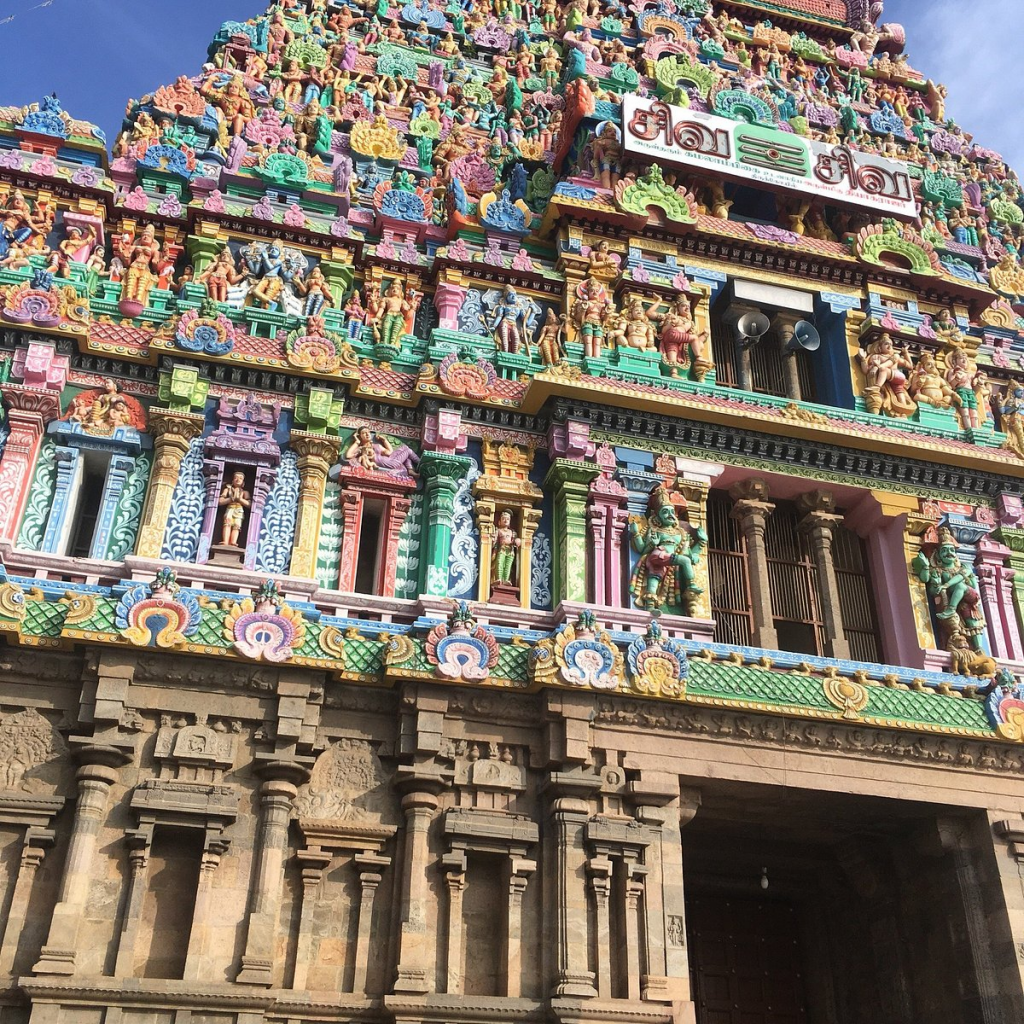Thyagaraja Temple is a Shiva temple located in the town of Thiruvarur in Tamil Nadu, India. Shiva is worshiped as Puttridankondar in this temple, and is represented by the lingam.

Daily poojas are offered to his idol referred to as Maragatha lingam. The main idol of worship is Lord veedhi Vidangar (processional icon) (Thiyagarajar), depicted as a Somaskanda form.

His consort Parvathi is depicted as Kondi. The presiding deity is revered in the 7th century Saiva canonical work, the Tevaram, written in Tamil by saint poets known as the nayanars and classified as Paadal Petra Sthalam.

The temple complex covers 30 acres, and is one of the largest in India. It houses nine gateway towers known as gopurams. The tallest is the eastern tower, with four stories and a height of 30 metres (98 ft).

The temple has numerous shrines, with those of Veedhi Vidangar (Thiyagarajar) and Alliyankothai (Neelothbalambal) being the most prominent.
The temple has six daily rituals at various times from 5:30 a.m. to 10 p.m., and twelve yearly festivals on its calendar. The temple has the largest chariot in Asia and the annual Chariot festival is celebrated during the month of March.

The present masonry structure was built during the Chola dynasty in the 9th century, while later expansions are attributed to Vijayanagar rulers of the Sangama Dynasty (1336–1485 CE), the Saluva Dynasty and the Tuluva Dynasty (1491–1570 CE).
The temple is maintained and administered by the Hindu Religious and Charitable Endowments Department of the Government of Tamil Nadu.
Shrines Inside Thyagaraja Swamy Temple in Tiruvarur
The Thyagaraja Swamy Temple, a grand edifice of religious and cultural importance in Tiruvarur, Tamil Nadu, houses a multitude of shrines within its expansive complex. Each of these shrines holds significant religious value and contributes to the temple’s rich tapestry of devotion and artistry.
Main Deity – Lord Thyagaraja (Shiva)
- Thyagaraja Shrine: The primary shrine is dedicated to Lord Thyagaraja, a form of Lord Shiva as the Lord of Dance. This shrine is the focal point of the temple and is revered for its mythological and spiritual significance.
Goddess Parvati Shrine
- Kamalambal Shrine: Adjacent to the main deity’s sanctum is the shrine for Goddess Kamalambal (Parvati), Lord Thyagaraja’s consort. This shrine is a prominent center for the worship of the Divine Feminine.
Lord Ganesha Shrine
- Ganesha Shrine: As in most Hindu temples, there is a dedicated shrine for Lord Ganesha, the remover of obstacles, usually found at the temple’s entrance.
Lord Murugan Shrine
- Murugan Shrine: Lord Murugan, the son of Shiva and Parvati, also has a dedicated shrine. It’s a significant spot for devotees, especially during festivals related to Lord Murugan.
Navagraha Shrine
- Navagraha Shrine: The temple includes a shrine for the Navagrahas, the nine planetary deities in Hindu astrology. This is a unique feature, catering to devotees seeking astrological blessings.
Vanmikanathar Shrine
- Vanmikanathar Shrine: Another important shrine in the temple is dedicated to Lord Vanmikanathar, representing another aspect of Lord Shiva.
Dakshinamurti Shrine
- Dakshinamurti Shrine: This shrine is dedicated to Lord Dakshinamurti, an aspect of Lord Shiva as the universal teacher. It holds great significance for seekers of spiritual knowledge.
Other Deities
- Various Smaller Shrines: The complex also houses several smaller shrines dedicated to various other deities and historical figures revered in Hinduism, each with its own set of rituals and festivals.
Court of Sacred Dance
- Nataraja Sabha (Hall of Dance): Although not a shrine in the traditional sense, this hall is critical to the temple’s identity, symbolizing the cosmic dance of Lord Shiva. It is a place where dance offerings are made.
Each shrine in the Thyagaraja Swamy Temple is not only a place of worship but also a representation of the rich mythological tapestry of Hinduism. The intricate sculptures and art in these shrines reflect the temple’s historical and cultural importance, making it a repository of religious art and architecture.
During the British Raj, the town was termed Tiruvalur, Tiruvaloor, and Thiruvalur. As per Hindu legend, the temple is the place where Kamalaambika’s penance to marry Thyagaraja remain unfulfilled.
History
The Thyagaraja Swamy Temple in Tiruvarur, located in Tamil Nadu, India, is a historically significant and revered Hindu temple. This temple is dedicated to Lord Shiva, known here as Thyagaraja (King of Dance), and is one of the largest temple complexes in India. Its history is deeply intertwined with the religious, cultural, and artistic traditions of the region.
Ancient Origins
- Mythological Foundations: The origins of the Thyagaraja Swamy Temple are steeped in Hindu mythology. It is believed to be one of the oldest temples in India, with references in ancient texts like the Puranas.
- Early Structures: The initial temple structure is thought to date back to the early Chola period, around the 7th century CE, although the site itself might have been significant even earlier.
Chola Dynasty Era
- Expansion and Renovation: The most significant phase of construction and expansion occurred during the Chola dynasty, especially under Rajaraja Chola I and his successors in the 10th and 11th centuries.
- Architectural Marvels: The temple is renowned for its magnificent architecture, featuring a massive chariot-shaped structure, grand gopurams (towering gateways), and intricate carvings.
Contributions of Other Dynasties
- Pandyas and Vijayanagar Empire: Subsequent rulers, including the Pandyas and the rulers of the Vijayanagar Empire, contributed to the temple’s development by adding various structures and mandapams (pillared halls).
- Cultural Patronage: These dynasties not only maintained the temple but also patronized art and culture, making Tiruvarur a hub of religious and artistic activities.
The Temple Today
- Religious Significance: The temple remains an active site of Hindu worship and is considered extremely sacred in Shaivism.
- Cultural Festivals: It hosts various festivals, the most famous being the annual chariot festival which attracts thousands of devotees.
Artistic and Cultural Influence
- Carnatic Music: Tiruvarur has a special place in the world of Carnatic music, with many legendary composers like Thyagaraja (after whom the temple is named), Muthuswami Dikshitar, and Syama Sastri being associated with this temple.
- Dance and Art: The temple has been a center for Bharatanatyam and other classical Indian dance forms, along with traditional art and craft practices.
Preservation and Heritage
- UNESCO World Heritage Site: Efforts have been made to declare it a UNESCO World Heritage Site, recognizing its historical, architectural, and cultural significance.
- Conservation Efforts: There are ongoing efforts to preserve and maintain this ancient temple, ensuring that its cultural legacy continues for future generations.
The Thyagaraja Swamy Temple in Tiruvarur is more than just a religious site; it is a symbol of the rich cultural heritage of Tamil Nadu and a testament to the artistic and architectural prowess of ancient Indian civilizations.
Architecture of Thyagaraja Swamy Temple in Tiruvarur
The Thyagaraja Swamy Temple in Tiruvarur, Tamil Nadu, is an architectural marvel, reflecting the grandeur of Dravidian temple architecture. This temple, dedicated to Lord Shiva, is renowned for its massive size, intricate sculptures, and the deep spiritual ambiance it offers. The architecture of the temple is a testament to the skill and devotion of its ancient builders, predominantly from the Chola dynasty.
Layout and Structure
- Vast Complex: The temple complex is one of the largest in India, featuring a series of concentric rectangular enclosures (prakarams) guarded by towering gopurams (gateway towers).
- Seven Enclosures: There are seven prakarams, each serving different religious and administrative functions, and adding layers of sanctity as one moves towards the central shrine.
Gopurams (Gateway Towers)
- Magnificent Gopurams: The temple is famous for its grand gopurams, which are visible from a distance and adorned with intricate carvings depicting various deities, mythological stories, and scenes from Hindu epics.
- Rajarajan Gopuram: The tallest and most famous gopuram, named after the great Chola king Rajaraja Chola I, is an outstanding example of Chola architectural brilliance.
Central Shrine
- Garbhagriha (Sanctum Sanctorum): The innermost sanctum houses the main deity, Lord Thyagaraja, in a form known as the ‘Ajapa Thanam’ (the dance pose that does not involve chanting).
- Unique Idol: Unlike typical Shiva temples where the lingam is the central idol, here the deity is in a somaskanda form, a rare depiction of Shiva with Uma and Skanda.
Mandapams (Pillared Halls)
- Thousand Pillared Hall: The temple boasts a large mandapam with a thousand pillars, featuring sculptures of deities, mythical animals, and dancers.
- Nritta Sabha: Known as the ‘Hall of Dance’, this structure is shaped like a chariot and is dedicated to the cosmic dance of Lord Shiva.
Sacred Tank
- Kamalalayam Tank: The temple’s large tank, Kamalalayam, is not only an architectural element but also a sacred space for rituals and festivals.
Art and Sculpture
- Sculptural Wealth: The walls, pillars, and towers of the temple are adorned with an abundance of sculptures that depict various gods, goddesses, mythical creatures, and scenes from Hindu mythology.
- Bronze Sculptures: The temple is also known for its collection of exquisite bronze sculptures from the Chola period, considered masterpieces of Indian metal art.
Architectural Innovations
- Stone and Metal Work: The temple showcases the advanced stone carving and bronze casting techniques of the Chola era.
- Symbolic Elements: Architectural elements like the gopurams and mandapams are not just artistic, but also have symbolic meanings, representing the cosmic and spiritual concepts of Hinduism.
The architecture of the Thyagaraja Swamy Temple in Tiruvarur is a blend of religious significance, artistic excellence, and architectural ingenuity. It stands as a proud symbol of the rich cultural heritage of Tamil Nadu and the enduring legacy of Dravidian temple architecture.
Similar architecture of halls (Mandapas) simulating a chariot drawn by elephant or horses is found in Sarangapani temple at Kumbakonam, Mela Kadambur Amirthakadeswarar Temple, Sikharagiriswara Temple, Kudumiyamalai, Nageswaraswamy Temple, Kumbakonam and Vriddhagiriswarar Temple, Vriddhachalam.
Chariot Festival of Thyagaraja Swamy Temple in Tiruvarur
The Chariot Festival (Rathotsavam) of the Thyagaraja Swamy Temple in Tiruvarur is one of the most spectacular and significant religious events in Tamil Nadu, India. This festival, a vibrant celebration of faith and tradition, attracts thousands of devotees from all over the country and is a key highlight of the temple’s annual calendar.
Historical and Cultural Significance
- Ancient Tradition: The Chariot Festival has been celebrated for centuries, with its origins tracing back to the time of the Chola dynasty, making it an integral part of the region’s cultural heritage.
- Symbolism: The festival symbolizes the Lord’s journey among his devotees, representing his blessing to the land and its people.
The Chariot (Ther)
- Massive Structure: The chariot used in the festival is one of the largest of its kind in Tamil Nadu, known for its immense size and intricate craftsmanship.
- Artistic Marvel: The chariot is a wooden structure, elaborately decorated with religious motifs and iconography, and often compared to a moving temple in its complexity and sanctity.
The Procession
- Rituals: The festival spans several days, with various religious rituals preceding the main chariot procession. These rituals include special pujas (worship ceremonies) and offerings.
- The Procession Day: On the main day, the deity’s idol is ceremoniously placed in the chariot, and the procession begins. Devotees pull the chariot through the streets of Tiruvarur, accompanied by music, chanting, and dance.
- Route of the Procession: The procession takes a traditional route through the town, allowing devotees to offer their prayers and respects.
Community Participation
- Sea of Devotees: The festival sees a massive gathering of devotees, participating in pulling the chariot and offering prayers.
- Cultural Performances: Alongside the religious aspects, the festival is a time for cultural expression, with performances of music, dance, and folk arts.
Festival Highlights
- Night Illumination: The chariot, when taken out during the evening or night, is often spectacularly illuminated, creating a mesmerizing sight.
- The Return Journey: After the day-long procession, the deity is brought back to the temple, marking the conclusion of the festival.
Spiritual and Social Impact
- Unity and Devotion: The festival is a powerful display of communal harmony and devotion, drawing people from various backgrounds to participate in a single act of faith.
- Tourism and Economy: It also significantly contributes to the local economy and tourism, as many visitors come to witness this grand event.
The Chariot Festival of the Thyagaraja Swamy Temple in Tiruvarur is more than just a religious event; it’s a vibrant celebration of Tamil Nadu’s rich spiritual traditions and cultural heritage, encapsulating the essence of devotion, art, and community spirit.
Ajapa Thanam at Thyagaraja Swamy Temple, Tiruvarur
The Thyagaraja Swamy Temple in Tiruvarur, a revered site in the state of Tamil Nadu, India, is renowned for its rich history and spiritual significance. Among its many unique aspects, the concept of “Ajapa Thanam” holds a special place. This term, rooted in Hindu spiritual practices, refers to the notion of effortless or spontaneous meditation, often associated with the continuous, subconscious repetition of a mantra.
In the context of the Thyagaraja Swamy Temple, Ajapa Thanam is believed to be a divine phenomenon. It is said that the deity worshipped in this temple, Lord Shiva, performs Ajapa Thanam perpetually. Devotees and spiritual seekers view this as a symbolic representation of the constant, unending nature of divine consciousness and presence. The belief is that Lord Shiva’s continuous meditation helps maintain the balance and harmony of the universe.
The temple, with its ancient architecture and deep spiritual ambiance, offers a conducive environment for devotees to engage in their meditation and spiritual practices, aiming to attain a similar state of continuous, effortless awareness. The concept of Ajapa Thanam in the Thyagaraja Swamy Temple thus serves as a reminder of the profound spiritual truths and eternal principles that lie at the heart of Hindu philosophy and religious practice.
Worship and religious practises
The temple priests perform the puja (rituals) during festivals and on a daily basis. Like other Shiva temples of Tamil Nadu, the priests belong to the Shaiva community, a Brahmin sub-caste.
The temple rituals are performed six times a day; Ushathkalam at 5:30 a.m., Kalasanthi at 8:00 a.m., Uchikalam at 10:00 a.m., Sayarakshai at 6:00 p.m., Irandamkalam at 7:00 p.m. and Ardha Jamam at 8:00 p.m.
It is believed that during Sayarakshai all the 33 crore devas (celestial beings) are present to worship Lord Thiyagarajar.
Further attending the Sayarakshai at Thiruvarur and then attending the Ardha Jamam pooja at Chidambaram is considered to be highly auspicious and beneficial.
There are weekly rituals like Somavaram (Monday) and Sukravaram (Friday), fortnightly rituals like Pradosham and monthly festivals like Amavasai (new moon day), kiruthigai, Pournami (full moon day) and Chathurthi.
The idol of Thiyagarajar is covered with a piece of cloth and flowers, so that only his and amman’s face is visible. His right foot and parvathy’s right foot are revealed on Aarudhra Dharshan in the month of Margazhi, while his left foot and amman’s left foot are revealed on Panguni Uthiram.
Music, dance and literature
Historically, Thiruvarur has been a centre of eminent people in religion, arts and science. Sundarar, an 8th-century Saivite saint, mentions “I am the slave of all those born in Thiruvarur” in his works in Tevaram.
Two of the 63 Nayanmars of Saivite tradition namely, Kalarsinga Nayanar and Tandiyadigal Nayanar were born in Thiruvarur.
The Periyapuranam, a 12th-century Saiva canonical by Sekkizhar, dedicates a chapter to those born in Thiruvarur, including these two saints.
The town was a traditional centre of music and dance – the inscriptions from Rajaraja Chola associate a large body of dancers associated with the temple.
Thiruvarur is home to Trinity of Carnatic music, namely Thyagaraja (1767–1847 CE), Muthuswami Dikshitar (1775–1835 CE) and Shyama Shastri (1762–1827 CE).

Muthuswami Dikshitar has sung eulogies of the temple deities of the Thyagarajaswami temple. Thyagaraja was named after the deity of this temple.
There was large influx of the acumen of South Indian culture to the town during the 17th century CE due to the political unrest in Thanjavur and increased patronage of the Maratha kings to Thiruvarur, resulting in developments in music and dance.
A unique musical instrument called Panchamuga Vadyam with each of its five ends ornamented differently is used in the temple.
A type of Nadaswaram (pipe instrument) called Barinayanam is also a unique instrument found only in Thiruvarur.
Thyagaraja Leelaikal is a work on the playful nature of the deity Thyagaraja of Thiruvarur. It is similar to the Thiruvilaiyadal Puranam in that it identifies Thyagaraja with the Cholas in the same way that the former identifies Meenakshi with the Pandyas. It is dated to the twelfth century CE.
Kumbhabhishekam of the temple was held on 8 November 2015. The heavy rains blow in Tiruvarur at the time of mahasamprokshanam, the people came in lot.
